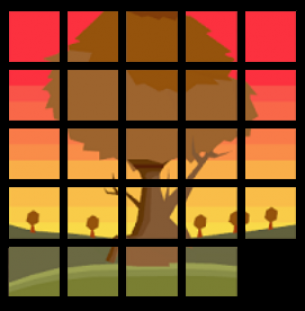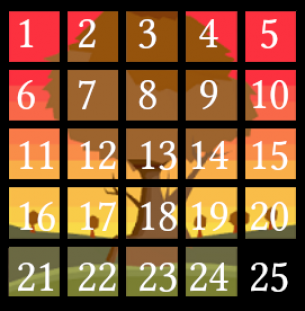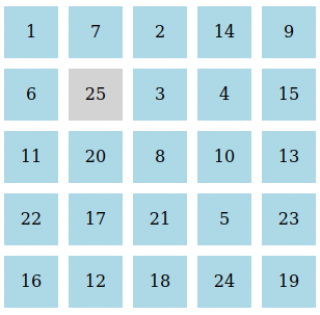A Quick Guide to Puzzle Box Solving Methods
Many years ago puzzle boxes were introduced to the original version of our game.1) These were 5 x 5 grids meant to emulate a game that first became a popular craze between 1870 and the 1880's.2),3),4)
In the game a player is presented with a picture broken into 24 square pieces and subsequently scrambled. One piece is blank and is the key to solving the puzzle. In order to solve this puzzle it is important to find an image of what the picture looks like when solved. For this discussion we will be using the following completed image.
Learning the general steps of the process can be important to applying them in a real scenario. Please remember this demonstration is just to illustrate the process involved. This particular solution is very unlikely to match any specific puzzle you may encounter.
The scrambled version of this image could vary significantly but will resemble something like the following image (which is the one we will be using for demonstration purposes).
To illustrate the process we begin by building a numbered reference based on the solved image.
Using this system we then label the images as they appear in the scrambled version above. In our example the scrambled array comes out to look like this:
Numbers can only be dragged into the grey space (25) at which point 25 will replace where that number once was.
Starting at the top left we begin to solve the array. Notice that, here, several numbers are already in their correct spots (1, 6, 11, 17, 24).
Working left to right be can easily assemble the first 3 numbers:
- Block 7 moves down into what is now block 25,
- block 2 moves left into what is now block 25,
- block 3 moves up into what is now block 25.
Note that this process winds up with the upper left grid of 4 completed as well! The array as completed so far appears on the right.
Our next task is to move the 4 block into the space currently occupied by the 14 block. To do this we will use a 3 x 3 circular block rotation to bring the blank 25 block into position above the 4 block.
- Block 8 moves up to block 25,
- block 10 moves left into what is now block 25,
- block 13 moves left into what is now block 25,
- block 15 moves down into what is now block 25,
- block 9 moves down into what is now block 25,
- block 14 moves right into what is now block 25,
- Now block 4 is free to move up to into what is now block 25.
The array as completed so far appears on the right.
Now we have to bring block 5 into its position.
First we rotate the upper right quadrant to get block 4 into the upper right corner.
- Block 9 moves left into what is now block 25,
- block 14 moves down into what is now block 25,
- block 4 moves right into what is now block 25,
- block 9 moves up into what is now block 25.
Now we go through the process of moving block 5 up to where it needs to be:
- Block 13 moves up into what is now block 25,
- block 5 moves up into what is now block 25,
- block 23 moves left into what is now block 25,
- block 15 moves down into what is now block 25,
- block 14 moves down into what is now block 25.
Continuing the process we do a simple 2 x 2 rotation…
- Block 13 moves right into what is now block 25,
- block 5 moves up into what is now block 25,
- block 14 moves left into what is now block 25,
- block 13 moves down into what is now block 25.
Now we do two rotations in the upper right quadrant:
- Block 4 moves down into what is now block 25,
- block 9 moves right into what is now block 25,
- block 5 moves up into what is now block 25,
- block 4 moves left into what is now block 25,
- block 9 moves down into what is now block 25,
- Block 5 moves right into what is now block 25,
- block 4 moves up into what is now block 25,
- block 9 moves left into what is now block 25.
As can be seen above, we have now completed the top row as well as the second row excepting the last block on the right.
Using these same general techniques the rest of the puzzle can be completed working left to right on each row going down.
It is generally suggested that puzzle boxes be worked in sections such as appear in the following image. In addition players are cautioned not to re-arrange blocks in a section after that area has been previously solved.
Note: This Page is a Work in Progress and subject to further modification as it is Under Construction!
Credits
* Zencro - 2 April 2023
Back to misc guidesplugin-autotooltip__default plugin-autotooltip_bigMiscellaneous Guides
Basic guides
* Getting Started * Commands * Prerequisite system
Item guides
* Ring of the Star sprite * Boots of the Lightness
Misc guides
* Moneymaking * Ectofuntus * Gravestones * Music List
---------- Back to main page
Back to main pageplugin-autotooltip__default plugin-autotooltip_bigstart
Welcome to 2009Scape wiki!













